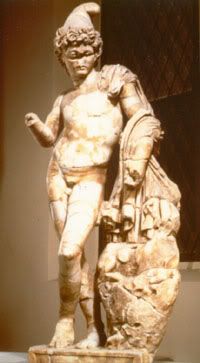

According to most stories, Attis was the indirect son of Agdistis. Agdistis was the hermaphrodite son of Zeus, born of his semen dropped upon Mount Ida next to where the Great goddess Cybele lay sleeping. Later the gods made Agdistis drunk and tied his genitals to a tree. He was castrate when he awoke and moved, and the almond tree grew up from his severed sexual organs. Nana, a nymph daughter of the river god, gathered the fruit into her lap and later gave birth to Attis. Other legends make him the foundling son of a king.
Attis is the Phrygian vegetation god also sometimes referred to as Papas, or the “father.” In some stories, he was the beloved of Cybele (Kybele). She chose him to be her priest and imposed a vow of chastity on him. He fell in love with a river nymph however, and Cybele caused him to go mad. In his fit of insanity, he castrated himself tree. Once he recovered and discovered his mutilation, he intended to kill himself, but Cybele changed him into a fir tree. According to another story, Agdistis appeared in the form of Cybele on the day of Attis’ wedding to a young maiden. Furious to see him professing his love to another woman, the girl killed herself. Mad with grief over her death, Attis then castrated himself under a pine tree. In a third version of the story, Attis was gored to death by a boar sent by Zeus. Spring flowers sprang up from his blood.
Each year at the end of March (March 22nd), a five day festival was held in honor of Attis. The first day was one of mourning. A sacred fir tree representing Attis was taken from the grove near Cybele’s temple. It was bound in bandages and decorated with ribbons and flowers before being carried through the streets. On the second day, Cybele’s priests carried on frenzied dances in effeminate clothes, culminating in their castrations or bloody slashes on the third day. They used their own blood to sprinkle the altar and effigy of Attis. On the fourth day, the resurrection of Attis was celebrated, and the fifth day was one of rest. A ritual marriage between Cybele and Attis was included in the celebrations, with her high priest acting the part of Attis.
The worship of Attis generally spread with that of Cybele. The Greeks and then the Romans gave worship to them. The Romans generally depicted Attis as a shepherd, usually carrying a shepherd’s crook and sometimes carrying a sheep on his shoulders. He played a pipe and wore a pointed cap. Rays of the sun or ears of corn protruded from the cap, symbolizing his role as a god of regeneration and rebirth.